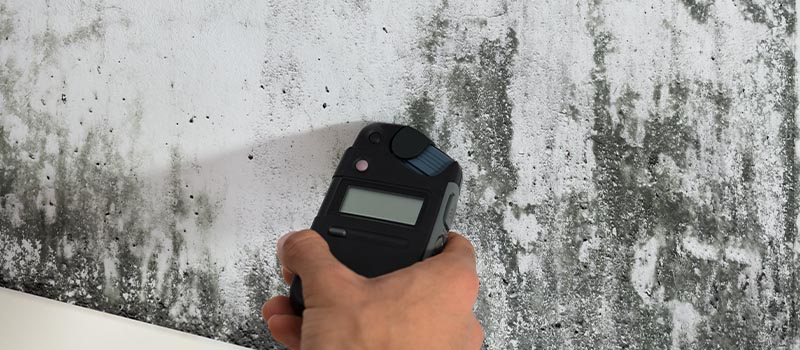Detecting mold growing behind walls in a finished basement can feel overwhelming for many homeowners. Furthermore, partnering with a trusted abatement & remediation company in Calgary ensures we have the expertise to identify hidden mold risks accurately.
Musty Odors and Unexplained Smells
A sharp or musty odor behind a wall often points to mold growth in the insulation or wood framing. For example, a lingering damp scent near baseboards indicates moisture trapped within the walls feeding mold colonies. Mold can thrive silently behind drywall where air circulation is low. Moreover, these unexplained smells tend to become stronger over time as the mold colony expands.
Water Stains and Paint Bubbles
Discoloration or water stains on drywall can signal moisture intrusion that molds love to exploit. In other words, a yellowish or brown patch may conceal a mold hotspot. Bubbling paint or peeling wallpaper often accompanies these water marks. Consequently, you should investigate any persistent stains before they lead to structural damage.
Warped Drywall and Wallpaper
Warped drywall that bulges outward hints at moisture buildup behind the surface. As a result, the drywall loses its rigidity and begins to buckle or swell. Wallpaper edges may lift when water undermines the glue. Therefore, warped wall coverings deserve prompt attention to prevent mold spread.
Increased Allergy Symptoms
Hidden mold often releases spores into indoor air that can trigger allergy flare ups. Consequently, unexplained sneezing or persistent congestion may trace back to an unseen mold colony. Our families can experience itchy eyes or irritated skin when spores circulate through vents. Furthermore, asthma symptoms tend to worsen when mold spores linger in confined spaces.
Discoloration Around Electrical Outlets
Dark spots or fuzzy growth near electrical outlets sometimes appear when mold develops behind the wall. Moreover, mold near electrical fixtures could mean ongoing moisture leaks from plumbing or basement walls. Detecting this issue early reduces the risk of electrical shorts and potential fire hazards. In addition, inspecting outlet areas can reveal mold before it spreads further inside wall cavities.
Persistent Humidity and Condensation
High humidity levels in a finished basement create the perfect environment for mold growth. Meanwhile, condensation on windows or cold spots on interior walls signals excess moisture. Storm water seeping into foundation cracks can raise humidity without obvious leaks. Therefore, controlling basement moisture helps prevent hidden mold from taking hold.
Hidden Indicators Revealed by Technology
Infrared cameras can detect cool spots behind walls where condensation and mold thrive. For instance, thermal imaging highlights temperature differences that point to wet areas hiding mold. At Envirotech we use moisture meters to measure dampness levels within drywall or wood surfaces. Consequently, these tools empower DIY inspectors to find areas prone to mold before extensive damage occurs.
DIY Moisture Meter Checks
A handheld moisture meter costs under twenty dollars and can pinpoint damp spots with ease. In addition, probing multiple wall areas helps map moisture patterns that favor mold formation. We recommend testing near plumbing lines and corners where airflow is minimal. Moreover, consistent high readings above twenty percent warrant further investigation by professionals.
When to Call in Professional Inspection
If visible signs or odd odors persist despite DIY checks we suggest scheduling a professional assessment. In other words, persistent warning signs often require trained inspectors to locate hidden mold colonies. Professional services can include detailed air sampling and surface testing to confirm mold species. Furthermore, comprehensive mold testing Calgary provides clear data so we can develop a targeted remediation plan.
Protective Precautions During Investigation
Wearing gloves and a protective mask helps reduce exposure when investigating areas prone to mold. However, loose protective equipment may spread spores if not handled properly. Sealing off rooms with plastic sheeting prevents spores from spreading during inspection. Therefore, taking safety seriously ensures we protect our health while identifying mold behind walls.
Ready to tackle hidden mold issues in your finished basement?
Most importantly, Contact Us so we can help protect your home.
Frequently Asked Questions
What causes mold to grow behind walls in finished basements
Mold grows when moisture from leaks or high humidity becomes trapped within wall cavities. It feeds on organic materials like wood and drywall paper.
How can I test for mold behind drywall
Homeowners can use moisture meters and thermal imaging to spot damp areas. For lab confirmation hiring a professional with sampling equipment is best.
Is mold behind walls dangerous to my health
Yes mold spores can trigger allergy symptoms and worsen respiratory issues when they spread in indoor air.
Can I remove mold behind walls myself
Small visible patches may be cleaned with proper protection but extensive growth requires professional removal to ensure safety and prevent spread.
How long does mold remediation take
Remediation time varies by the extent of growth but most projects take one to three days to complete. Larger jobs or structural repairs may extend the schedule beyond that window.

